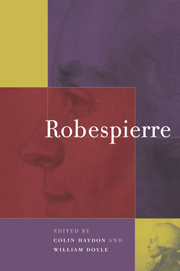Book contents
- Frontmatter
- Contents
- List of contributors
- Acknowledgements
- List of abbreviations
- Part I Introduction
- Part II Robespierre's outlook
- Part III Robespierre's politics
- Part IV Robespierre in retrospect
- 11 Carlyle's seagreen Robespierre and the perilous delights of picturesque history
- 12 Robespierre through the Chartist looking-glass
- 13 Rehabilitating Robespierre: Albert Mathiez and Georges Lefebvre as defenders of the Incorruptible
- 14 Robespierre in French fiction
- 15 The representation of Robespierre in European drama
- Part V Conclusion
- Index
13 - Rehabilitating Robespierre: Albert Mathiez and Georges Lefebvre as defenders of the Incorruptible
Published online by Cambridge University Press: 14 January 2010
- Frontmatter
- Contents
- List of contributors
- Acknowledgements
- List of abbreviations
- Part I Introduction
- Part II Robespierre's outlook
- Part III Robespierre's politics
- Part IV Robespierre in retrospect
- 11 Carlyle's seagreen Robespierre and the perilous delights of picturesque history
- 12 Robespierre through the Chartist looking-glass
- 13 Rehabilitating Robespierre: Albert Mathiez and Georges Lefebvre as defenders of the Incorruptible
- 14 Robespierre in French fiction
- 15 The representation of Robespierre in European drama
- Part V Conclusion
- Index
Summary
On 28 July 1794 (10 Thermidor Year II), Maximilien Marie Isidore Robespierre was taken from the Conciergerie prison and carted through Paris streets lined with shouting crowds. Deposited in the place de la Revolution, he watched as two of his colleagues from the Committee of Public Safety and his younger brother Augustin mounted the scaffold and were beheaded. When he himself finally climbed the steps and was tied to the plank, the executioner ripped away the bandage that bound his jaw, shattered by a bullet at the time of his capture. The celebrated orator died shrieking an animal cry of pain. Within a few hours his corpse along with those of his companions disappeared into a common grave at a Parisian cemetery.
Two hundred years have passed since Robespierre's mortal life ended and his posthumous one began. His career has been closely scrutinised by historians, repeatedly narrated by biographers, vividly described by novelists, and melodramatically depicted by film-makers. But if the outline of his political career is familiar, his complex personality remains rather cryptic and the controversy over his behaviour continues to be lively.
To his many admirers, Robespierre was the leading figure of the Revolution; to his detractors, he was its great villain. The sharp and prolonged debate between defenders and opponents greatly exasperated the historian Marc Bloch, who, in his Historian's Craft, written in 1941, exclaimed: ‘Robespierrists, anti-Robespierrists, we've had enough. We say, for pity's sake, simply tell us what Robespierre was really like.’
Two prominent Robespierrists, whose work Bloch may surely have had in mind, were Albert Mathiez and Georges Lefebvre.
- Type
- Chapter
- Information
- Robespierre , pp. 212 - 223Publisher: Cambridge University PressPrint publication year: 1999



